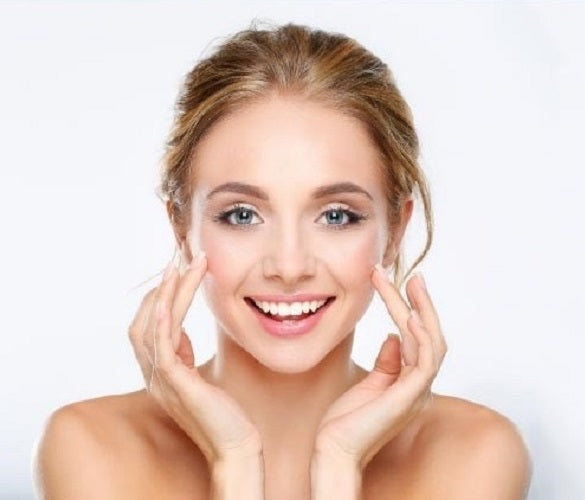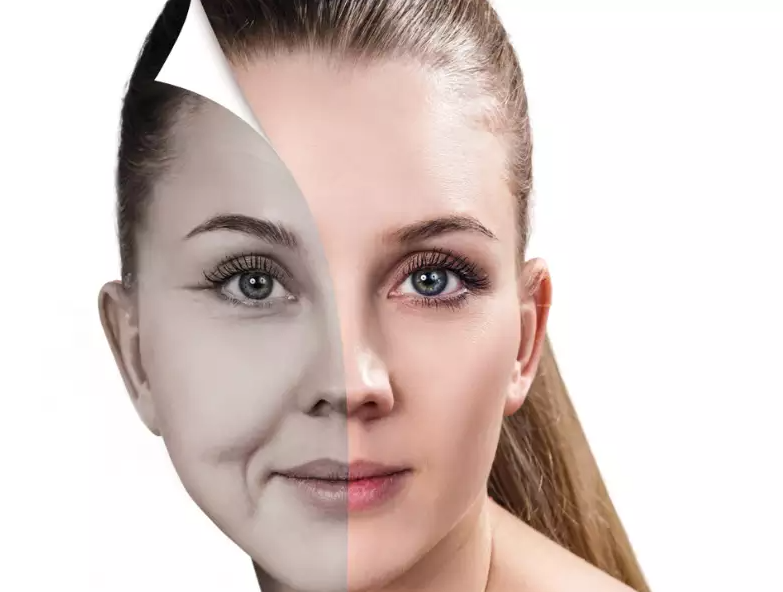Medically Reviewed by Dr. Lisa Hartford, MD
Several internal and external factors govern skin health. Internal factors like age and genetics are pretty significant. Furthermore, external factors such as diet, lifestyle habits, sun exposure, and skin care regime also impact skin health.
A proactive approach to skincare is necessary to combat the adverse effect of all these factors. Some people may get surgical enhancement or injections to remove sagging skin and wrinkles. On the other hand, most people may prefer noninvasive treatments to ensure their youthful appearance.
Treatments like Red LED therapy and microcurrent have proven effective in skin rejuvenation through collagen production and muscle tightening. Moreover, using active skincare ingredients in tandem with these treatments may result in even more effective rejuvenation.
Read further as we discuss combining microcurrent and topical antioxidants to improve skin health.
Effect of Microcurrent on Skin
Microcurrent is a new noninvasive method to rejuvenate skin. A low current is passed through the skin, stimulating deep layers and muscles. The treatment has no side effects or healing time; therefore, it is convenient for improved skin appearance. Moreover, it has proven effects for eliminating fine lines and wrinkles.

In a study, 45 or below thirty women participated to study the impact of microcurrent treatment. They all had visible wrinkles on the forehead, nose, and around mouth. The clinical trial started with documenting their current wrinkles and fine lines with pictures to use for comparison later.
They were given microcurrent treatment for twenty minutes for thirty consecutive days. Their photos were taken to compare with the initial photos. In addition, three independent blinded reviewers concluded the clinical trial results.
As per the evaluation, there was an improvement of 21.18% in forehead wrinkles. The second-best result was for the mouth and nose wrinkles, with an improvement of 7.61%. Also, 70% of participants were satisfied with the treatment as they could see its effects after one month of stopping it.
What are Topical Antioxidants?
Topical antioxidants are known to prevent skin aging and cell damage. Mostly, antioxidants are present in our food; however, they may be included in skin care for their multiple benefits. Antioxidants are active ingredients in skincare that improve the skin with consistent use.
Skin cells may get damaged due to UV rays, pollution, poor lifestyle, and aging. As a result, the cells release free radicals and trigger oxidative stress. This causes fine lines, wrinkles, uneven skin tone, dark spots, and saggy skin.
One way to prevent skin damage is to use topical antioxidants in the form of creams, serums, and moisturizers. These antioxidant ingredients may be natural or synthetic. Some of the common naturally produced antioxidants are glutathione, carotenoids, zinc, selenium, and vitamins A, C, and E.
Antioxidants may help to prevent UV radiation damage that is responsible for causing skin aging signs. Consuming an antioxidant-rich diet and using antioxidant skincare may help reduce this damage. Furthermore, carotenoids support the health of the epidermis, and zinc creates new cells.
In addition, vitamin E is excellent for decreasing the risk of skin cancer. Selenium may also prevent wrinkles and fine lines in the skin. Vitamin C enhances collagen formation in the skin through proline and lysine residues hydroxylation to hydroxyproline and hydroxylysine. Vitamin A(retinol) increases cell turnover to regenerate new cells and decrease the appearance of fine lines.
According to twenty scientific studies, antioxidants help with skin conditions such as acne, dermatitis, and vitiligo. Vitamin E may reduce severe psoriasis and heal the skin quicker.
Choosing the suitable topical antioxidants for skin
A recent study concluded the efficacy of antioxidants in skin health both topically and orally. Therefore, it’s wise to include antioxidants in your diet and skincare. Your choice of antioxidants in skincare will depend on skin type and sensitivity levels.
Choose the right product to determine if your skin is dry, combination, or oily. If your skin is sensitive, it’s best to do a patch test and proceed with the product. Retinol is ideal for acne scars, wrinkles, and fine lines. It is a derivative of vitamin A that increases cell turnover.
As a result, the aging signs diminish with constant use leaving you with rejuvenated skin. Moreover, vitamin A reduces skin texture and uneven skin tone.
Going slow is better when you start using vitamin A-based skincare or retinol than overdoing it. Use it once in four days and move to two to three days once your skin gets used to the active ingredient.
Another excellent antioxidant is vitamin C, with brightening effects. Vitamin C is ideal for most skin types. However, a patch test is still recommended. One thing to remember is to use sun protection when using active ingredients, as they may sensitize the skin. Also, add a soothing moisturizer with vitamin C to nourish the skin.
Hydrating hyaluronic acid may be a solution if you have sensitive skin. Moreover, it works on dehydrated aging skin. You may use it as creams, emulsions, lotions, and serums. They all will add a hydrating effect on the skin while improving its elasticity.
Combining Microcurrent and Topical Antioxidants for Healthy Skin
As mentioned earlier, using microcurrent therapy and topical antioxidants may be a potent way to revive your skin. With the power of microcurrent massaging and active antioxidants, your skin cells will regenerate and repair, diminishing aging signs and dullness.
With regular use, your skin may look brighter and appear firmer. Microcurrent facials are better for those who wish to get a facelift without going under the knife.
At-Home Microcurrent and Antioxidant Facial
Earlier, microcurrent facials were only available at dermatologist clinics. Now with the availability of premium at-home devices, you can get the benefits of treatment. Combine it with an antioxidant serum or gel to help glide the device easily.
We suggest using the Phoenix microcurrent bar to treat facial and neck wrinkles. It has 4 alloy rollers attached to it. These rollers offer a deep kneading massage to the facial tissues. The best thing is that the device recharges with artificial or solar light. So, you do not have to worry about running out of batteries or plug-in the device.

Just use it in a well-lit room. Treat one area for 15-20 minutes. You may cover your whole face in 45-60 minutes while relaxing at home. The 15-microampere current of the Phoenix device will lift your skin.
You may use EvenSkyn hyaluronic acid conduction gel to lubricate the skin while using the microcurrent bar. Your skin will feel hydrated after the treatment. And within four weeks, you’ll notice a lifted appearance in your skin.
After the facial, you may also use vitamin C products to brighten your skin. The synergistic effect of microcurrent therapy with antioxidants may show the desirable results quicker.
Wrapping Up
Now you know how to amplify the effectiveness of microcurrent and antioxidants for youthful-looking skin. You can achieve your ultimate goal of flawless and glowing skin by combining these proven ingredients with microcurrent facials.
These treatments are great as a precautionary measure, even if you do not have visible wrinkles. If your skin has started to show aging signs, it may be the best way to delve into new skin treatments to retain your youthfulness.
With consistent use, you may see an even skin tone, diminished fine lines, and wrinkles. Moreover, a good skin treatment regime may also delay the signs of aging, preventing them from appearing early on.
References:
- Vierkötter A, Krutmann J. “Environmental influences on skin aging and ethnic-specific manifestations.” July 2012
- Oresajo C, Pillai S, Manco M, Yatskayer M, McDaniel D. “Antioxidants and the skin: understanding formulation and efficacy.” June 2012
- Dunaway S, Odin R, Zhou L, Ji L, Zhang Y, Kadekaro. “Natural Antioxidants: Multiple Mechanisms to Protect Skin From Solar Radiation.” April 2018
- Darvin ME, Sterry W, Lademann J, Vergou T. “The Role of Carotenoids in Human Skin. Molecules.” December 2011
- Ogawa Y, Kinoshita M, Shimada S, Kawamura T. “Zinc and Skin Disorders.” February 2018
- Burke KE, Clive J, Combs GF Jr, Commisso J, Keen CL, Nakamura RM. “Effects of topical and oral vitamin E on pigmentation and skin cancer induced by ultraviolet irradiation in Skh:2 hairless mice.” 2000.
- Michalak M, Pierzak M, Kręcisz B, Suliga E. “Bioactive Compounds for Skin Health: A Review. Nutrients.” January 2021
- Zasada M, Budzisz E. Retinoids: active molecules influencing skin structure formation in cosmetic and dermatological treatments.” August 2019
- Xiaofang Liu, Guang Yang, Mengxin Luo, Qi Lan. “Serum vitamin E levels and chronic inflammatory skin diseases: A systematic review and meta-analysis.” December 2021
- Addor FAS. “Antioxidants in dermatology.” June 2017
- Telang PS. “Vitamin C in dermatology.” April 2013









Leave a comment
All comments are moderated before being published.
This site is protected by hCaptcha and the hCaptcha Privacy Policy and Terms of Service apply.